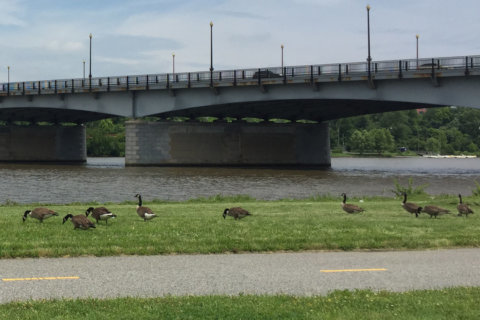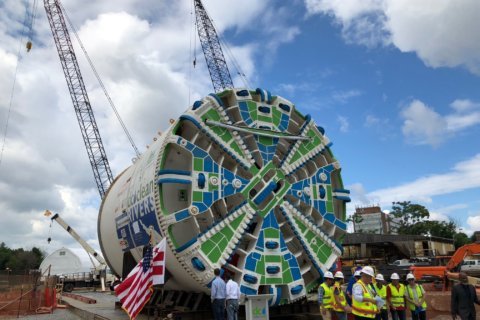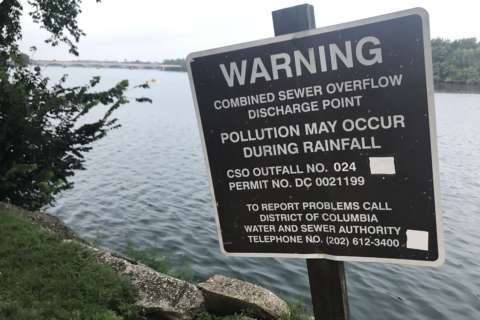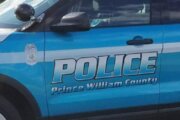




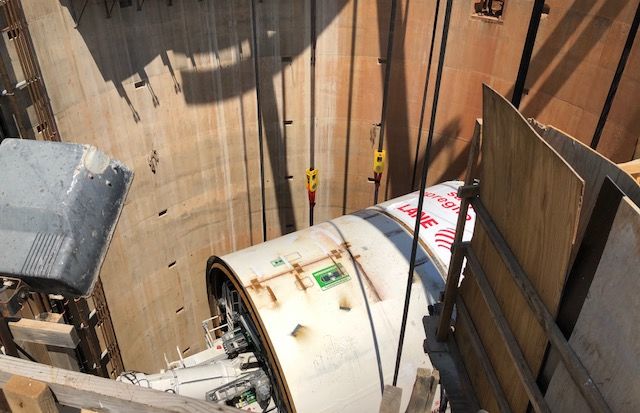
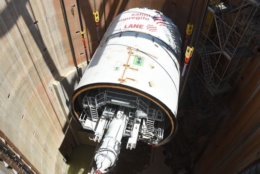
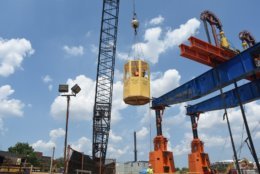
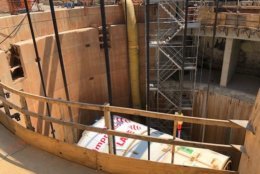
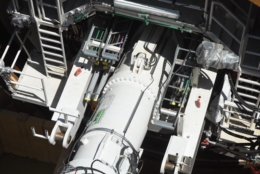
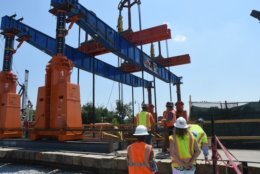
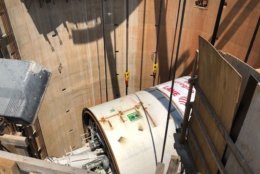
WASHINGTON — A massive infrastructure project will be taking place underneath millions of residents and commuters in Northeast D.C. over the next several years, and the centerpiece of the project is taking the stage.
Inch by inch, the 680-ton, cylindrical tunnel-boring machine known as “Chris” was carefully lowered in a 100-foot deep shaft just west of the Anacostia River on Thursday.
The behemoth will spend the next two and a half years slowly chewing through more than 5 miles of earth underneath Northeast D.C., from near Robert F. Kennedy Stadium toward Rhode Island Avenue and Shaw.
Once complete, the Northeast Boundary Tunnel formed in Chris’ wake will divert 98 percent of combined sewer overflow away from the Anacostia River and toward Blue Plains Treatment Plant on the south side of the District, according to DC Water.
Shafts that lead from the ground level into the tunnel will further alleviate the sewer system in neighborhoods, such as Bloomingdale, that are frequently overwhelmed during heavy rains and flash flooding.
The NEBT will connect to a network of tunnels, including the new Anacostia Tunnel, to help keep sewage and trash out of the river. Once thought of as a marine wasteland, wildlife and recreational fishers and boaters have been making a comeback in recent years thanks in large part to the District’s pledge to revitalize the watershed. For the first time ever, the river received a passing grade of “D-” on its 2018 “State of the River” report card, led by the incredible regrowth of submerged aquatic vegetation.
“We’ve already constructed three tunnels to date. Two of the tunnels, the Blue Plains Tunnel that was constructed with ‘Lady Bird,’ and the Anacostia River Tunnel, that was constructed by ‘Nannie,’ has been placed into operation as of March 20, 2018,” said Carlton Ray, the director of the Clean Rivers Project for DC Water.
Ray said that the tunnel system was immediately tested by a nor’easter in late March and drenching rains in mid April and has since diverted over a billion and a half gallons of raw or combined sewage toward Blue Plains along with 10 tons of trash.
“It’s already doing great work,” Ray said, and added that the NEBT will further reduce sewage run-off into the watershed.
“The First Street Tunnel is a short term solution. Once we connect it with the new tunnel that we’re constructing with Chris, a drop of water will flow from First Street by McMillian Reservoir nearly 13 miles all the way down to Blue Plains,” Ray said.
Out with the old, out in the new
First, there were outhouses. Next came simple sewer systems that piped all wastewater directly into the nearby rivers. Then, around the turn of the 20th century, sewer interceptors were installed.
“Those interceptors were basically to capture all of the dry-weather flow and some wet-weather flow but not all the flow,” Ray said.
Like many towns and cities in the Northeast and Midwest, the District has an antiquated combined sewer system that sends wastewater directly into the nearby waterways during heavy rain.
The current conduit for wastewater through Northeast runs underneath Florida Avenue toward the Atlas neighborhood, then southward underneath Stadium Armory where wet-weather sewage was once ejected directly into the Anacostia River. The overflow from the outfall near the river has recently been diverted into the new Anacostia River tunnel system, according to DC Water.
Portions of the trunk sewer line are as narrow as 10 feet in diameter in some places, including the leg that runs below North Capitol Street. During downpours, the result has been overflows in streets and basements.
The new tunnel that Chris will be digging will not replace the sewer interceptors, but it will increase the capacity of the sewer system.
“We’re doing a couple major things: greatly diminishing the overflow volume that’s going into the Anacostia, allowing people to fish and swim, and then also to address the long-term flooding problem that’s been going on since the 1800s in the Northeast part of the District,” Ray said.
Washington’s ‘Big Dig’
The tunnel-boring machine, held by 19 high-strength steel cables, was lowered below ground with an overhead strandjack system Thursday.
“Once the machine is lowered into position, we need to push it ahead a bit to get it pushed into the eye, and then we need to make all of the connections to the trailing gear,” said Shane Yanagisawa, project manager for Lane Construction, one of the central contractors overseeing construction of the tunnel.
Yanagisawa called the mammoth cylinder the “business end.” The sled that the boring machine will pull behind it through the newly ringed tunnel segments will be longer than a football field.
Crews estimate that the boring could begin as soon as August, once the various power and hydraulic connections are made between the machine and its equipment sled.
Past tunnel boring machines along the Anacostia River have managed to chew through about 40 feet of earth per day. Some days see faster progress than others.
“Every time it advances 6 feet, we erect a concrete lining. Once we build a single ring 6-feet wide, then the machine pushes off to move another 6 feet. So as we advance, you’re never seeing the ground because the ground is either supported by the tunnel-boring machine, or it’s supported by the concrete lining,” Yanagisawa said.
A giant screw will feed sediment from the rotating cutter head at the front of the machine to the back. The dirt is feed to the back of the machine, onto a conveyor belt where it is hauled out of the tunnel onto dump trucks.
The inside diameter of the NEBT, similar to the tunnels it will connect to, will be 23 feet, significantly wider than the underground Metrorail tunnels. At certain locations, the tunnel will be 160 feet below ground – deeper below ground than the District’s height restrictions above ground.
The tunnel boring machine was named Chris, in honor of Christopher Allen, the assistant director for the Clean Rivers Project who passed away suddenly last year.
“Chris used to be the head of our construction group. He was an amazing man. He ran the tunneling group for both the Blue Plains Tunnel and the Anacostia Tunnel. He was a great guy,” Ray said.
As Chris nears its final destination, below the intersection of R Street and 6th Street in Northwest, various shafts will be constructed from street level toward the tunnel.
The entire system is scheduled to begin carrying storm water toward Blue Plains by August 2023.


